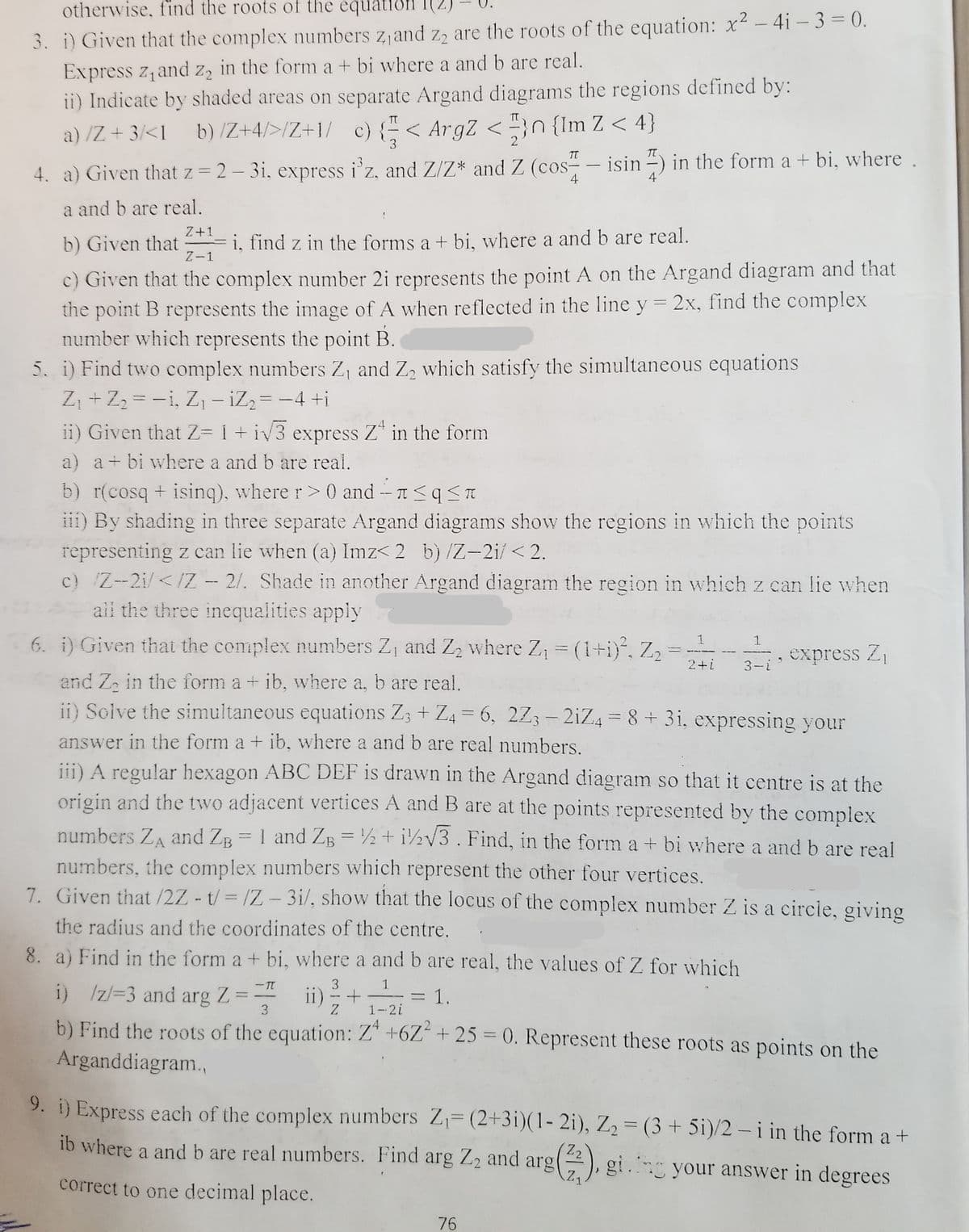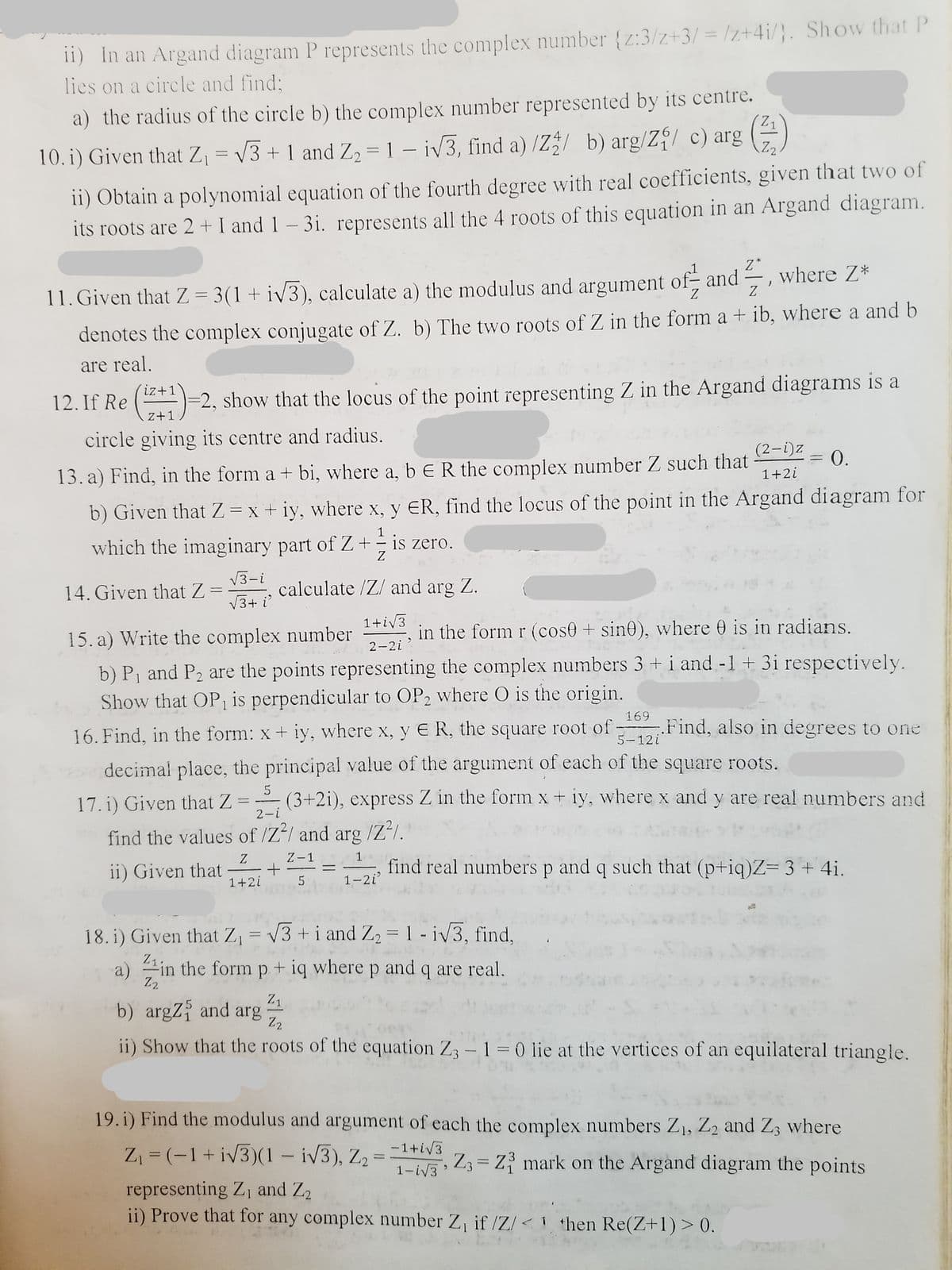9. i) Express each of the complex numbers Z (2+3i)(1- 2i), Z2 = (3+ 5i)/2 - i in the form a + ib where a and b are real numbers. Find arg Z2 and arg( Z2 gi. your answer in degrees correct to one decimal place.
9. i) Express each of the complex numbers Z (2+3i)(1- 2i), Z2 = (3+ 5i)/2 - i in the form a + ib where a and b are real numbers. Find arg Z2 and arg( Z2 gi. your answer in degrees correct to one decimal place.
Linear Algebra: A Modern Introduction
4th Edition
ISBN:9781285463247
Author:David Poole
Publisher:David Poole
Chapter7: Distance And Approximation
Section7.1: Inner Product Spaces
Problem 7AEXP
Related questions
Concept explainers
Equations and Inequations
Equations and inequalities describe the relationship between two mathematical expressions.
Linear Functions
A linear function can just be a constant, or it can be the constant multiplied with the variable like x or y. If the variables are of the form, x2, x1/2 or y2 it is not linear. The exponent over the variables should always be 1.
Question
Solve all Q9 explaining detailly each step

Transcribed Image Text:otherwise, find the roots of the equatiön
3. i) Given that the complex numbers z,and z, are the roots of the equation: x² - 4i – 3 = 0.
Express z,and z, in the form a + bi where a and b are real.
ii) Indicate by shaded areas on separate Argand diagrams the regions defined by:
a) /Z + 3/<1_b) /Z+4/>/Z+1/ c) {"< ArgZ < "}n {Im Z < 4}
%3D
3
2
T
- isin -)
in the form a + bi, where .
:3
4. a) Given that z = 2- 3i, express i'z, and Z/Z* and Z (cos-
4
4
a and b are real.
Z+1
b) Given that
Fi, find z in the forms a + bi, where a and b are real.
Z-1
c) Given that the complex number 2i represents the point A on the Argand diagram and that
the point B represents the image of A when reflected in the line y = 2x, find the complex
number which represents the point B.
5. i) Find two complex numbers Z, and Z, which satisfy the simultaneous equations
Z, + Z2 = -i, Z, – iZ2= -4 +i
ii) Given that Z= 1 + iv3 express Z* in the form
|
a) a+ bi where a and b are real.
b) r(cosq + isinq), where r> 0 and - 1<q<I
iii) By shading in three separate Argand diagrams show the regions in which the points
representing z can lie when (a) Imz< 2 b) /Z-2i/ < 2.
c) Z--2i/</Z - 2/. Shade in another Argand diagram the region in whichz can lie when
ail the three inequalities apply
6. i) Given thati the complex numbers Z, and Z2 where Z, = (1+i), Z2
1
1
express Z
2+i
3-i
and Za in the form a + ib, where a, b are real.
ii) Solve the simultaneous equations Z; + Z4 = 6, 2Z; - 2iZ4 = 8+ 3i, expressing your
%3D
answer in the form a + ib, where a and b are real numbers.
iii) A regular hexagon ABC DEF is drawn in the Argand diagram so that it centre is at the
origin and the two adjacent vertices A and B are at the points represented by the complex
numbers ZA and ZB = 1 and ZB = ½ + i½v3. Find, in the form a + bi where a and b are real
numbers, the complex numbers which represent the other four vertices.
7. Given that /2Z - t/= /Z-3i/, show that the locus of the complex number Z is a circle, giving
%3D
the radius and the coordinates of the centre.
8. a) Find in the form a + bi, where a and b are real, the values of Z for which
3
i) /z/=3 and arg Z
ii) + =1.
= 1.
1-2i
3
b) Find the roots of the equation: Z* +6Z“ + 25 = 0. Represent these roots as points on the
Arganddiagram.,
9. i) Express each of the complex numbers Z= (2+3i)(1- 2i), Z2 = (3 + 5i)/2 - i in the form a +
%3D
%3D
Z2
ib where a and b are real numbers. Find arg Z2 and arg
gi.ng your answer in degrees
Z1
correct to one decimal place.
76

Transcribed Image Text:11) In an Argand diagram P represents the complex number {z:3/z+3/ = /z+4i/}. Show that P
lies on a circle and find;
a) the radius of the circle b) the complex number represented by its centre.
Z2
10. i) Given that Z, = V3 + 1 and Z, = 1 – iv3, find a) /Z b) arg/Z/ c) arg
ii) Obtain a polynomial equation of the fourth degree with real coefficients, given that two of
its roots are 2 + I and 1 – 3i. represents all the 4 roots of this equation in an Argand diagram.
Z*
where Z*
__
Z.
Z
11. Given that Z = 3(1+iV3), calculate a) the modulus and argument of- and
denotes the complex conjugate of Z. b) The two roots of Z in the form a + ib, where a and b
are real.
iz+1
12. If Re ()=2, show that the locus of the point representing Z in the Argand diagrams is a
z+1
circle giving its centre and radius.
(2-i)z
= 0.
13. a) Find, in the form a + bi, where a, b E R the complex number Z such that
1+2i
%3D
b) Given that Z = x + iy, where x, y ER, find the locus of the point in the Argand diagram for
1
which the imaginary part of Z +- is zero.
V3-i
calculate /Z/ and arg Z.
14. Given that Z
V3+ i
1+iv3
15. a) Write the complex number
in the form r (cose + sin0), where 0 is in radians.
2-2i
b) P1 and P2 are the points representing the complex numbers 3 +i and -1 + 3i respectively.
Show that OP1 is perpendicular to OP2 where O is the origin.
169
Find, also in degrees to one
16. Find, in the form: x + iy, where x, y E R, the square root of
5-12i
decimal place, the principal value of the argument of each of the square roots.
5
(3+2i), express Z in the form x + iy, where x and y are real numbers and
17. i) Given that Z
2-i
find the values of /Z/ and arg /Z²/.
Z
Z-1
1
ii) Given that
1+2i
find real numbers p and q such that (p+iq)Z= 3+4i.
1-2i
18. i) Given that Z, = v3 + i and Z2 = 1 - iv3, find,
%3D
21in the form p + iq where p and q are real.
Z2
Z1
b) argZ and arg
Z2
ii) Show that the roots of the equation Z3 -1 = 0 lie at the vertices of an equilateral triangle.
19. i) Find the modulus and argument of each the complex numbers Z1, Z2 and Z3 where
-1+iV3
Z, = (-1+ iv3)(1 – iv3), Z2 =
1-iV3
Z3 = Z mark on the Argand diagram the points
representing Z1 and Z2
ii) Prove that for any complex number Z, if /Z/<1 then Re(Z+1) > 0.
Expert Solution
This question has been solved!
Explore an expertly crafted, step-by-step solution for a thorough understanding of key concepts.
Step by step
Solved in 4 steps with 4 images

Knowledge Booster
Learn more about
Need a deep-dive on the concept behind this application? Look no further. Learn more about this topic, algebra and related others by exploring similar questions and additional content below.Recommended textbooks for you

Linear Algebra: A Modern Introduction
Algebra
ISBN:
9781285463247
Author:
David Poole
Publisher:
Cengage Learning

Algebra & Trigonometry with Analytic Geometry
Algebra
ISBN:
9781133382119
Author:
Swokowski
Publisher:
Cengage

Elementary Geometry For College Students, 7e
Geometry
ISBN:
9781337614085
Author:
Alexander, Daniel C.; Koeberlein, Geralyn M.
Publisher:
Cengage,

Linear Algebra: A Modern Introduction
Algebra
ISBN:
9781285463247
Author:
David Poole
Publisher:
Cengage Learning

Algebra & Trigonometry with Analytic Geometry
Algebra
ISBN:
9781133382119
Author:
Swokowski
Publisher:
Cengage

Elementary Geometry For College Students, 7e
Geometry
ISBN:
9781337614085
Author:
Alexander, Daniel C.; Koeberlein, Geralyn M.
Publisher:
Cengage,

Trigonometry (MindTap Course List)
Trigonometry
ISBN:
9781337278461
Author:
Ron Larson
Publisher:
Cengage Learning

Elements Of Modern Algebra
Algebra
ISBN:
9781285463230
Author:
Gilbert, Linda, Jimmie
Publisher:
Cengage Learning,

College Algebra
Algebra
ISBN:
9781305115545
Author:
James Stewart, Lothar Redlin, Saleem Watson
Publisher:
Cengage Learning